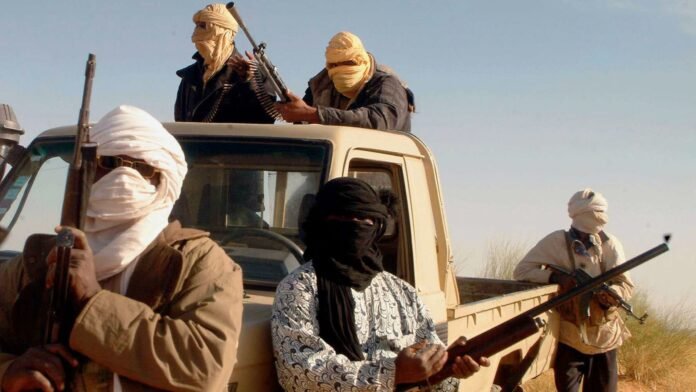The Sahel region has faced multiple crises for decades, but it is far from a weakened state slipping into further turmoil. Terror groups are resurging and establishing the Sahel as their base. In recent years, Jihadist groups have carried out symbolic attacks to demonstrate their presence, creating an impression of fragmentation and limited capabilities.
However, this view is now shifting toward more organised and hardened Jihadist groups that are exploiting the Sahel’s crises to re-establish themselves on the global terror scene. The crises in the Sahel are caused not only by governance failures but also by security vacuums and narrow geopolitical interests. The West is making the same mistake it made in Afghanistan.
The Phase Of Colonial Struggle
The Sahel region was under colonial rule by France, where the French focused solely on resource extraction and neglected governance, leading to significant governance gaps in the area. Even the borders of the Sahel were arbitrarily drawn, dividing ethnic groups across different countries and weakening national cohesion.
After independence from France, frustration grew among nomadic and tribal groups as limited governance began to fail, marking the start of extremism and rebellion after the 1960s. This rebellion and violent tendencies escalated when the Sahel was hit by famine and drought, and in the 1980s, issues such as banditry, kidnapping, extortion, and the killing of French citizens became more prevalent.
The Beginning of Jihad In Sahel
The Sahel region practiced moderate Sufi Islam, but soon the North African area saw the first signs of Jihadi conflict—specifically the outbreak of the Algerian civil war in 1991, when the government cancelled elections out of fear that Islamist forces might gain power.
These forces effectively capitalised on public frustration against the government and fuelled the radicalisation of armed Islamic groups. The military intervened, leading to a coup and a civil war between armed Islamic groups and the military.
Terror groups are resurging and establishing the Sahel as their base. In recent years, Jihadist groups have carried out symbolic attacks to demonstrate their presence, creating an impression of fragmentation and limited capabilities
This episode laid the foundation for the emergence of Islamist forces in the political vacuum and their subsequent rise. During the civil war, Osama Bin Laden’s visit to Sudan in 1992, where he established Al-Qaeda’s training camps and business operations, marked Al-Qaeda’s growing influence in the region, as evidenced by the bombing of US embassies in Kenya in 1998.
Later, in 2007, the Islamist group Algeria Armed Islamic Group was rebranded as Al-Qaeda in the Islamic Maghreb (AQIM) after pledging allegiance to Al-Qaeda. AQIM moved further south to Mali and Niger and became involved in smuggling and banditry to fund terrorist activities.
Al-Qaeda’s terror outreach in the Sahel region expanded after 9/11, as the US’s war on terror campaign pushed the group out of its traditional strongholds—the Middle East and Asia—toward Africa, thanks to the Sahel’s porous borders and unstable governments with political vacuums.
Early to mid-2000s saw the making of a Jihadi landscape in the Sahel region that solidified after the fall of Muammar Gaddafi in Libya.
Expansion of Jihadi Landscape
In 2011, the fall of Gaddafi in Libya provided Al-Qaeda with an opportunity to exploit the large political and security vacuum, especially in Mali. After his regime collapsed, a significant stockpile of weapons was released.
Notably, the Tuareg tribal rebels, who had worked as mercenaries for Gaddafi, were also freed. These rebels later aligned with AQIM, strengthening Al-Qaeda. The alliance of rebels and AQIM was later exploited by the rebels’ separatist demands for autonomy in the Azawad region of Mali.
This triggered a major 2012 rebellion in Mali with Islamist influences and led to the occupation of northern Mali. By April 2012, Islamist forces had taken control of key cities in Mali, resulting in a new wave of Jihadists in the region.
Consolidation of Jihadist Wave In Sahel
In 2013, the West recognised the increasing terror threat in Africa. France launched a counterterrorism operation named Serval to remove Jihadist groups from Northern Mali. It was a tactical success but caused Jihadist groups to retreat further into the region, especially into neighboring areas, giving them the opportunity to regroup and destabilise the region more.
France then started another operation from 2014 to 2022 called Barkhane, aimed at stabilising the Sahel region. However, it achieved only limited success as French troops faced strong local resentment linked to colonial history.
With two major operations failing, the region continued to suffer from political and security gaps. To make matters worse, poverty and governance problems fuelled people’s anger, pushing them to take up arms and bolstering Islamist forces.
The Sahel region practiced moderate Sufi Islam, but soon the North African area saw the first signs of Jihadi conflict—specifically the outbreak of the Algerian civil war in 1991, when the government cancelled elections out of fear that Islamist forces might gain power
A Dangerous Jihadist Unity And Series of Coups
In 2015, ISIS entered the African landscape, and a breakaway faction from AQIM, pledged allegiance to ISIS. This group became known as Islamic State in the Greater Sahara (ISGS).
After two years, Al-Qaeda strengthened its position by merging AQIM with two Islamist forces—Ansar al-Dine and al-Mourabitoun—to form JNIM, a powerful Al-Qaeda group that is currently at the forefront of terror attacks in the region.
Since 2020, there have been six successful coups in the Sahel region, plunging the area into a political vacuum with weak governing capabilities. This has allowed ISGS and Al-Qaeda to expand and reinforce their presence.
As criminal activities increased, these terror groups adopted banditry with Jihadist motives—Jihadist Banditry—encouraging criminal groups to adopt Jihadist ideologies and migrate into terrorism.
This has significantly bolstered Al-Qaeda and ISIS’s presence in the Sahel in recent years. Consequently, the region now accounts for over 50% of global terrorism deaths, making it a top global terrorism hotspot. Burkina Faso alone saw 1,135 deaths in 2022, making it the world’s most terror-affected country.
Narrow Geopolitics And Limited Attention
Africa has gradually become the center of geopolitics and geoeconomics due to its rare earth elements and gold potential, but it will have little or no benefit until a complex security and political environment prevails in the Sahel region.
After France withdrew, Russia’s private mercenaries, the Wagner group, arrived. The military junta gained some security assurances and a reason to pivot toward Russia.
However, even Wagner’s presence has not been able to deliver notable results, and the Islamic State continues to dominate. This limited success of Wagner stems from their narrow objectives of Russian influence and gold mining, rather than a serious security response in Africa.
Al-Qaeda’s terror outreach in the Sahel region expanded after 9/11, as the US’s war on terror campaign pushed the group out of its traditional strongholds—the Middle East and Asia—toward Africa, thanks to the Sahel’s porous borders and unstable governments with political vacuums
An interesting discussion here is the US’s limited attention, despite the Russian presence on African soil. The US keeps the Sahel at a low strategic priority, as it feels there is no direct threat from terror groups with limited striking capabilities.
The US also considers involvement in African conflicts risky, given its haunting past with the Somali crisis, where it faced one of its biggest failures—Operation Gothic Serpent.
The US had an operational presence in Niger, but it was limited to surveillance and reconnaissance activities and was withdrawn in 2024. The US and France also withdrew from the region in 2024, with limited Russian success. Terror groups still stand a strong chance of resurgence.
The Terror Threat Is Real: US Counter Terrorism Needs Wake Up Call
US counterterror assessments have experienced multiple failures. The US underestimated Al-Qaeda’s transnational reach, and in 1998, Al-Qaeda carried out a terror attack on the US embassy in Africa with planning from Afghanistan.
Similarly, the US failed to recognise a secret Jihadist revolution in Africa—the Algerian Civil War—where Algerian Islamist forces aligned with Al-Qaeda and built contacts with the global terror network.
In 2015, ISIS entered the African landscape, and a breakaway faction from AQIM, pledged allegiance to ISIS. This group became known as Islamic State in the Greater Sahara (ISGS)
In Somalia, the US once again underestimated the regional Islamist force, Al-Itihaad al-Islamiya, and its ties with Al-Qaeda, while focusing on humanitarian operations. This oversight contributed to the formation of Al-Shabaab, a powerful Islamic terror group with allegiance to Al-Qaeda.
The list doesn’t end here; the US also failed to assess the ideological leanings of Narco cartels’ Jihadists in Colombia, which led to cartel bombings in 1998.
Al-Qaeda’s JNIM heavily depends on the drug network, and the US still fails to evaluate the wider narco-terror threat that will grow and empower terror groups. The threat of resurgence is now common; the real danger is that terror groups are acquiring the capabilities for transnational terror attacks and influence.
The US must learn from its mistakes, and the global order must rise above geopolitics and economics to address collective political and security gaps to prevent another wave of global Jihadists.
The writer is a national security analyst specialising in intelligence and strategic affairs. He has worked extensively with national security and foreign policy think tanks of repute, and has written for publications including The Telegraph, The Print, Organiser, and Fair Observer. He has also been a guest contributor to the School of International Studies at Jawaharlal Nehru University (JNU).






